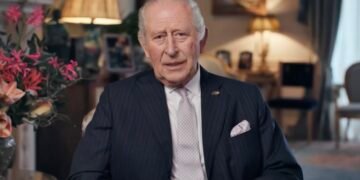The Vladimir tiara consists of 15 intertwined diamond loops, with a waves of stones snaking their way through these loops, as pendants of pearls – which can be changed for emeralds – hang from them. These circles sit atop a row of brilliant-cut diamonds. It was made for Grand Duchess Vladimir of Russia by court jewellers, Bolin, probably at the time of her marriage in 1874.
The Queen has often interchanged its usability with a typical nod to her hosts, wearing it with pearl drops for a visit to the Vatican, or emerald drops for a visit with the President of Ireland; most recently, we saw this version for the Diplomatic Corps reception.

On occasion, she has worn it with no drops at all.
You may have seen the Vladimir Tiara in all its various fabulous guises numerous times, but did you know it has a fascinating story behind it too?
Smuggled out of Russia following the assassination of Tsar Nicholas II and his family, the Vladimir Tiara had originally belonged to the wife of the Tsar’s uncle, the glamorous Grand Duchess Vladimir of Russia, who died in France 1920 having been the last Romanov to escape Russia.
Embed from Getty Images Embed from Getty Images
Born in Germany to the Grand Duke of Mecklenburg-Schwerin, Maria Pavlovna became Grand Duchess of Russia upon her marriage in 1874 and “the grandest of the Grand Duchesses” was well known for her impressive collection of jewels and love of parties.
When the Tsar was forced to abdicate in favour of Lenin’s new Communist government in 1917, the Grand Duchess, upon receiving news of the revolution, left St. Petersburg with only a few “daytime jewels and strings of pearls”, and hid her remaining gems in a secret compartment in the Vladimir Palace. She then fled to the Caucasus with her sons, in the hope that a coup would help one of them to gain control of the county.
In the meantime, family friend and diplomatic courier Albert Stopford – a British antiques and art dealer who specialised in Fabergé and Cartier – managed to retrieve 224 jewels, including the tiara from the Duchess’s safe in the Palace, taking them back to safety in England. Sneaking into the Vladimir Palace dressed as a worker, he stashed all the hidden jewels in his bags, making it safely out of Russia and to London, where Maria’s son, Grand Duke Boris, was living in exile.
Following the Duchess’ death three years later, her jewels were sold to support her children, with many European Royals bidding to buy the pieces.
Queen Mary, with her love of jewels and gems, bought the Vladimir tiara. The piece had been damaged in transit – a few pearls had gone missing and some diamonds were loose – so Queen Mary sent it to Garrards for repair, taking the opportunity to have 15 emeralds that had once belonged to her mother the Duchess of Cambridge set as pendants. A mechanism that allowed the gorgeous green stones to be swapped with the original pearls was added to the tiara.
Queen Mary left the vast majority of her jewels and tiaras to our current Queen who has made frequent use of the Vladimir. Whilst it is undoubtedly a stunning piece of workmanship, its versatility lends it to multiple uses – gorgeous and practical?! What a dream!

So many of The Queen’s tiara’s are said to be her favourite that it’s difficult to pinpoint just one. The Girls of Great Britain and Ireland tiara is probably her most-worn, thanks to its light frame. But amongst of all the tiaras in her vault, few can rival the backstory and versatility of the Vladimir…









